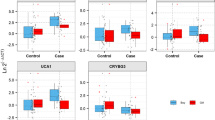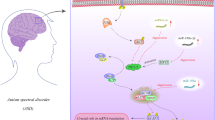Abstract
Long non-coding RNAs (lncRNAs) have been recognized as an important epigenetic factor in the evolution of neuropsychiatric conditions. We have selected five lncRNAs (DISC2, PRKAR2A-AS1, LOC105375675, LRRC2-AS1, and LOC101928237) to measure their expression in blood samples of children with autism spectrum disorder (ASD) versus children with normal development. Expressions of DISC2, PRKAR2A-AS1 and LOC101928237 have been enhanced in ASD cases compared with healthy children (Posterior Beta = 2.508, P value<0.0001; Posterior Beta = 2.793, P value = 0.014 and Posterior Beta = 1.646, P value <0.0001, respectively). On the other hand, expression of LRRC2-AS1 has been lower in ASD patients compared with controls (Posterior Beta = −3.781, P value<0.0001). Remarkably, expression of DISC2 and PRKAR2A-AS1 have been lower in girls compared with boys (Posterior Beta = −0.982, P value<0.0001 and Posterior Beta = −0.135, P value<0.0001, respectively). In addition, expression of DISC2 has been lower in ASD cases aged more than 6 compared with those aged less than 6 years (Posterior Beta = −0.876, P value = 0.003). DISC2, LOC101928237, LRRC2-AS1, and PRKAR2A-AS1 had the area under curve (AUC) values of 0.76, 0.90, 0.92, and 0.79 in distinguishing between ASD and healthy children. Expression levels of none of DISC2, LOC101928237, LOC105375675, LRRC2-AS1, and PRKAR2A-AS1 were correlated with age of ASD cases or healthy controls. A significant correlation was detected between expressions of DISC2 and PRKAR2A-AS1. There were inverse correlations between the following pairs of lncRNAs: DISC2/LRRC2-AS1, DISC2/LOC101928237, LRRC2-AS1/PRKAR2A-AS1, LOC101928237/LRRC2-AS1, and LOC101928237 /LOC105375675. We conclude that DISC2, LOC101928237, LRRC2-AS1, and PRKAR2A-AS1 might be used as potential markers for this condition.



Similar content being viewed by others
Data availability
The analyzed data sets generated during the study are available from the corresponding author on reasonable request.
References
Abrahams BS, Geschwind DH (2008) Advances in autism genetics: on the threshold of a new neurobiology. Nat Rev Genet 9:341–355
Bjørklund G, Kern JK, Urbina MA, Saad K, El-Houfey AA, Geier DA, Chirumbolo S, Geier MR, Mehta JA, Aaseth J (2018) Cerebral hypoperfusion in autism spectrum disorder. Acta Neurobiol Exp (Wars) 78:21–29
Bröer S, Gether U (2012) The solute carrier 6 family of transporters. Br J Pharmacol 167:256–278
Clark BS, Blackshaw S (2014) Long non-coding RNA-dependent transcriptional regulation in neuronal development and disease. Front Genet 5:164
Cogill SB, Srivastava AK, Yang MQ, Wang L (2018) Co-expression of long non-coding RNAs and autism risk genes in the developing human brain. BMC Syst Biol 12:91
Ehrlich KC, Lacey M, Ehrlich M (2020) Epigenetics of skeletal muscle-associated genes in the ASB, LRRC, TMEM, and OSBPL gene families. Epigenomes 4:1
Eshraghi AA, Liu G, Kay S-IS, Eshraghi RS, Mittal J, Moshiree B, Mittal R (2018) Epigenetics and autism Spectrum disorder: is there a correlation? Front Cell Neurosci 12:78
Francoeur N, Gandal M, Xu X, Sarpong K, Johnson J, Sklar P, van Bakel H, Geschwind D, Pinto D (2019) Assessing the role of long noncoding RNAs (LncRNAs) in autism spectrum disorders. Eur Neuropsychopharmacol 29:S960
Guo Y, Zhang P, Sheng Q, Zhao S, Hackett TA (2016) lncRNA expression in the auditory forebrain during postnatal development. Gene 593:201–216
Lichtenstein P, Carlström E, Råstam M, Gillberg C, Anckarsäter H (2010) The genetics of autism spectrum disorders and related neuropsychiatric disorders in childhood. Am J Psychiatr 167:1357–1363
Lin M, Pedrosa E, Shah A, Hrabovsky A, Maqbool S, Zheng D, Lachman HM (2011) RNA-Seq of human neurons derived from iPS cells reveals candidate long non-coding RNAs involved in neurogenesis and neuropsychiatric disorders. PLoS One 6:e23356
London E, Wester JC, Bloyd MS, Bettencourt S, McBain CJ, Stratakis CA (2020) Loss of habenular Prkar2a reduces hedonic eating and increases exercise motivation. JCI insight 5:e141670
Mandrekar JN (2010) Receiver operating characteristic curve in diagnostic test assessment. J Thorac Oncol 5:1315–1316
Marrocco J, McEwen BS (2016) Sex in the brain: hormones and sex differences. Dialogues Clin Neurosci 18:373–383
Millar JK, James R, Brandon N, Thomson P (2004) DISC1 and DISC2: discovering and dissecting molecular mechanisms underlying psychiatric illness. Ann Med 36:367–378
Musso G, Plebani M (2019) Blood biomarkers in neurology:“a call to arms” for laboratory professionals. Clin Chem Lab Med 57:1433–1434
Naghavi-Gargari B, Zahirodin A, Ghaderian SMH, Shirvani-Farsani Z (2019) Significant increasing of DISC2 long non-coding RNA expression as a potential biomarker in bipolar disorder. Neurosci Lett 696:206–211
Pozzo F, Bittolo T, Tissino E, Vit F, Vendramini E, Laurenti L, D’Arena G, Olivieri J, Pozzato G, Zaja F, Chiarenza A (2020) SF3B1-mutated chronic lymphocytic leukemia shows evidence of NOTCH1 pathway activation including CD20 downregulation. Haematologica. https://doi.org/10.3324/haematol.2020.261891
Schroeder A, De Wit J (2018) Leucine-rich repeat-containing synaptic adhesion molecules as organizers of synaptic specificity and diversity. Exp Mol Med 50:1–9
Szikszai K, Krejcik Z, Klema J, Loudova N, Hrustincova A, Belickova M, Hruba M, Vesela J, Stranecky V, Kundrat D (2020) LncRNA profiling reveals that the deregulation of H19, WT1-AS, TCL6, and LEF1-AS1 is associated with higher-risk Myelodysplastic syndrome. Cancers 12:2726
van Kerkhof LWM, Damsteegt R, Trezza V, Voorn P, Vanderschuren LJMJ (2013) Functional integrity of the habenula is necessary for social play behaviour in rats. Eur J Neurosci 38:3465–3475
Vannucchi G, Perugi G, Masi G (2019) Bipolar disorder and ASD. In: Psychopathology in adolescents and adults with autism spectrum disorders. Springer, Cham, pp 89–110
Watters JJ, Dorsa DM (1998) Transcriptional effects of estrogen on neuronal neurotensin gene expression involve cAMP/protein kinase A-dependent signaling mechanisms. J Neurosci 18:6672–6680
Wilkinson B, Campbell DB (2013) Contribution of long noncoding RNAs to autism spectrum disorder risk. Int Rev Neurobiol 113:35–59
Zhang Y, Xiang Z, Jia Y, He X, Wang L, Cui W (2019) The notch signaling pathway inhibitor Dapt alleviates autism-like behavior, autophagy and dendritic spine density abnormalities in a valproic acid-induced animal model of autism. Prog Neuro-Psychopharmacol Biol Psychiatry 94:109644
Acknowledgements
This study was financially supported by Shahid Beheshti University of Medica Sciences.
Author information
Authors and Affiliations
Contributions
KH and MDO performed the experiment. FP and SAJ analyzed the data. MT and SGF designed the study and wrote the draft and revised it. All the authors contribute equally and read the submission.
Corresponding authors
Ethics declarations
Ethics approval and consent to participate
All procedures performed in studies involving human participants were in accordance with the ethical standards of the institutional and/or national research committee and with the 1964 Helsinki declaration and its later amendments or comparable ethical standards. Informed consent forms were obtained from all study participants. The study protocol was approved by the ethical committee of Shahid Beheshti University of Medical Sciences (IR.SBMU.MSP.REC.1399.14). All methods were performed in accordance with the relevant guidelines and regulations.
Consent for publication
Not applicable.
Competing interests
The authors declare they have nothing to report.
Additional information
Publisher’s note
Springer Nature remains neutral with regard to jurisdictional claims in published maps and institutional affiliations.
Rights and permissions
About this article
Cite this article
Tamizkar, K.H., Ghafouri-Fard, S., Omrani, M.D. et al. Altered expression of lncRNAs in autism spectrum disorder. Metab Brain Dis 36, 983–990 (2021). https://doi.org/10.1007/s11011-021-00681-z
Received:
Accepted:
Published:
Issue Date:
DOI: https://doi.org/10.1007/s11011-021-00681-z




